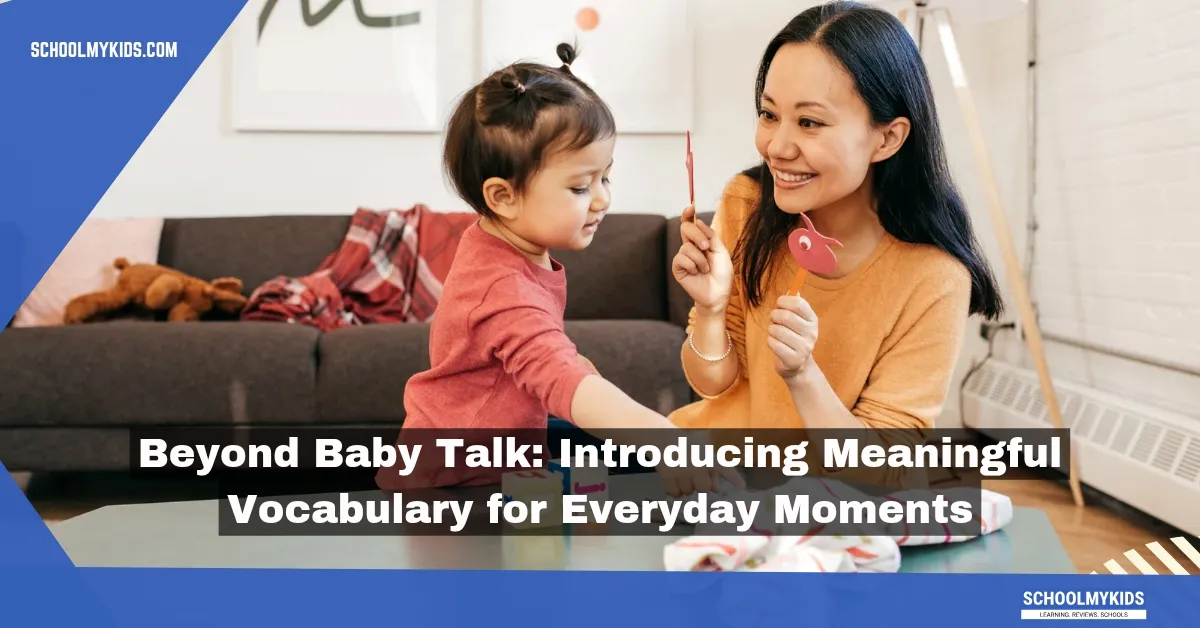Picture this: Your one-year-old is pointing frantically at their sippy cup on the counter, making that urgent "uh! uh!" sound we all know too well. You could simply hand it over, or you could seize this perfect teachable moment with a simple phrase: "Oh, you want your cup? Here's your cup!"
Just like that, you've taken a step beyond baby talk into meaningful vocabulary. But which words should you focus on? When should you introduce them? And how do you do it without turning your precious quality time into flashcard drills?
Let's explore!
Why Focus on Real Words?
Think about it: at one year old, your baby is already a little explorer, eager to interact with the world. Giving them the words to express themselves unlocks a whole new level of understanding and connection.
- Boosts Communication: Imagine your child being able to say "more" when they want another bite of banana or "up" when they want to be lifted. Fewer frustrated cries and more happy interactions!
- Cognitive Development: Learning new words isn't just about vocabulary. It also helps your child understand concepts, make connections, and build those all-important brain pathways.
- Emotional Growth: Being able to express their feelings, even in simple terms like "happy" or "sad," helps your child develop emotional intelligence and feel understood.
What Words Should You Teach?
Here are some word categories your 1-year-old can start learning:
Social Words (The Connection Builders)
These are the words that help your little one feel connected to others:
- "Hi" and "Bye-bye" (often a child's first words!)
- "Please" and "Thank you"
- "More" and “Sorry”
- "Yes" and "No"
Action Words (The Doing Words)
These verbs help children express what they want to do or what they see happening:
- "Eat" and "Drink"
- "Go" and "Stop"
- "Up" and "Down"
- "Open" and "Close"
- "Give" (or the toddler version: "gimme!")
Nouns (The Name-It Words)
These concrete objects are part of your child's everyday experience:
- People: "Mama," "Dada," "Baby"
- Food items: "Milk," "Juice," "Cookie," "Banana"
- Beloved objects: "Ball," "Book," "Blanket"
- Animals they encounter in books or real life: "Dog," "Cat," "Bird"
Descriptive Words (The How-It-Is Words)
Simple adjectives that describe the world:
- "Hot" and "Cold"
- "Big" and "Little"
- "Wet" and "Dry"
Body Part Words (The Self-Discovery Words)
These help children understand their own bodies:
- "Eyes," "Nose," and "Mouth"
- "Ears" and "Hair"
- "Hands" and "Feet"
- "Tummy" and "Back"
Sound Words (The Sensory Vocabulary)
Onomatopoeic words are often easier for children to pronounce and remember:
- Animal sounds: "Woof," "Meow," and "Moo"
- Vehicle sounds: "Vroom" and "Beep"
- Environmental sounds: "Boom," "Splash," and "Bang"
Safety Words (The Protection Vocabulary)
Simple words that help keep children safe:
- "Hot" and "Owie"
- "Gentle"
- "Wait," "Slow," and "Stop"
Making Learning Fun (and Not Overwhelming!)
Now for the million-dollar question: How do you teach these words without turning your home into a pressure-cooker language academy? The answer is surprisingly simple: weave them into your everyday moments.
Narrate Your Day
Your one-year-old is your constant companion as you move through your day. Try narrating simple actions:
"I'm washing your hands. The water is wet. Now, let's dry them with the towel."
"Look, we're going up the stairs! One, two, three steps up."
The repetition and context help cement these words in your child's mind.
Follow Their Lead
Notice what captivates your child's attention and use that interest as a vocabulary springboard:
When they point at the family dog: "Yes, that's our dog! The dog says 'woof woof.' Do you want to pet the dog?"
When they're fascinated by your coffee mug: "This is my cup. It's hot. Mama drinks coffee from her cup."
Make It Playful, Not Pressured
The key is keeping language learning natural and fun:
- Play simple games like peek-a-boo while using words like "hide" and "find."
- Sing songs that incorporate target words (like "The Wheels on the Bus" for action words)
- Use exaggerated manners and facial expressions to make words memorable.
Create Word-Rich Routines
Daily routines provide natural opportunities for repetition:
- Mealtime: "Time to eat! Here's your spoon. Do you want more bananas?"
- Bath time: "Let's wash your toes. The water is wet. Your rubber duck goes splash!"
- Bedtime: "Let's read a book. Look at the star in the sky. Time to sleep."
When Less Is More: Avoiding Vocabulary Overload
While it's exciting to introduce new words, remember that quality trumps quantity. Here's how to keep it manageable:
- Focus on 5-10 new words at a time across different categories
- Use the words consistently for several days or weeks before adding new ones
- Pay attention to your child's cues – if they seem overwhelmed, slow down
- Celebrate approximations – if "ba" means "ball" to your child, that's a win!
Signs Your Approach Is Working
How do you know if your vocabulary-building efforts are making a difference? Look for these encouraging signs:
- Your child attempts to imitate words you use often
- They start to respond appropriately to familiar words (looking up when you say "light")
- They use consistent sounds to refer to specific objects or people
- They become more persistent in their communication attempts
Remember that receptive vocabulary (words they understand) develops much faster than expressive vocabulary (words they can say). Your child likely understands a lot more words than they can speak!
Conclusion
Remember, this isn't about turning your child into a mini-genius. It's about building connections, communication, and a love of language. So, relax, have fun, and enjoy this amazing journey of discovery with your baby!








Be the first one to comment on this story.